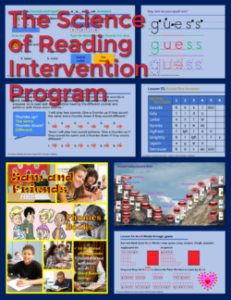Secondary Reading Intervention

The Science of Reading Intervention Program for Ages 8-Adults
If you were tasked with developing a secondary reading intervention program from “the ground up,” where would you start and what resources would you consider using? I’ve been there and done that a few times with plenty of mis-steps and quite a few success stories.
Disclaimer: I’m the author/publisher of a reading intervention program for ages 8-adult. The following link will allow you to access the entire print portion of the program (not the corresponding Google slides): https://penningtonpublishing.com/collections/reading/products/the-science-of-reading-intervention-program-bundle
Now to the heart of my question: “If you were developing a secondary reading RTI program from the ground up, what materials/programs would you include?”
That is precisely the question that 23 reading specialist colleagues faced 20 years ago in a large and diverse California school district. Our reading test percentiles were in the 40s and we were locked into what became balanced literacy instruction. Enter one of the first SOR programs: Open Court. With a generous grant, our district was able to hire and train another 24 literacy coaches in Open Court for beginning readers.
Our reading scores increased dramatically into the 70 and later the 80 percentiles. However, our ages 8-high school scores remained stagnant. Our reading specialists were tasked with creating both upper elementary and secondary reading curricula for grade-level and intervention to pick up where Open Court and our fantastic teachers left off. Our progressive district incentivized those of us who took the lead in writing program resources by freeing us up from teaching duties and allowing us to retain ownership of what we created. All of this to say that I’ve had the challenge and pleasure of creating a secondary reading intervention from “the ground up.”
A few suggestions:
For trained reading intervention teachers, a “add this, use that” piecemeal approach is fine; however, not so for most secondary teachers who are content experts, but not reading experts. Although the suggested resources in this post’s comments are terrific, inexperienced secondary teachers will feel more comfortable using one comprehensive program. Less training, less juggling and coordinating programs, less time management issues.
My next suggestion will definitely get some pushback. Beware of “one size fits all” claims regarding program materials. Yes, a high school student who does not understand the alphabetic principle has the same needs as a beginning reader, but the quickest way to shut down a secondary student or teacher is to squeeze a primary “square peg” into a secondary “round hole.” For example, using childish decodables are not acceptable; my 54 decodables feature teenage illustrations, themes, and plots.
Additionally, be careful to construct or use a program which has realistic time parameters. You’re not going to be able to cram 90 minutes of instruction into a 50 minute period. Select instructional resources which will allow you to prioritize, cut, and/or expand to your instructional minutes. In other words, flexibility is key.
One last consideration: I’m sure you are familiar with Scarborough’s Rope. Make sure that you incorporate both word recognition and language comprehension instruction in your intervention. Both are essential, but the latter is critically important for secondary students.